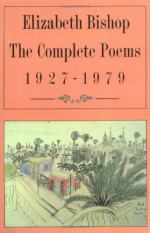
|
| Name: _________________________ | Period: ___________________ |
This test consists of 15 multiple choice questions and 5 short answer questions.
Multiple Choice Questions
1. What does the speaker use in line 5 as an example of a common lost object?
(a) Socks.
(b) Pens.
(c) Glasses.
(d) Keys.
2. How many refrains does "One Art" contain?
(a) 3.
(b) 4.
(c) 2.
(d) 1.
3. Which technique is used in the speaker's claim to have lost "some realms I owned, two rivers, a continent" (line 14)?
(a) Hyperbole.
(b) Imagery.
(c) Personification.
(d) Simile.
4. How many stanzas does "One Art" have?
(a) 6.
(b) 9.
(c) 8.
(d) 7.
5. What is the name of the metrical foot that appears at the end of lines 1 and 3 in most of the stanzas?
(a) Anapest.
(b) Tribrach.
(c) Amphibrach.
(d) Dactyl.
6. In lines 2 and 3, "so many things seem filled with the intent/ to be lost that their loss is no disaster," what is the antecedent of the word "their"?
(a) Many.
(b) Lost.
(c) Things.
(d) Intent.
7. What is used for the first time in the poem's final stanza?
(a) Sentence fragments.
(b) Parenthetical expressions.
(c) Modifying phrases.
(d) Coordinating conjunctions.
8. What technique is employed in line 16, "Even losing you"?
(a) Understatement.
(b) Apostrophe.
(c) Dramatic irony.
(d) Sarcasm.
9. What is different about the final stanza of "One Art"?
(a) It has an extra line.
(b) It is written in free verse.
(c) It reverses the rhyme pattern of the previous stanzas.
(d) Every line is endstopped.
10. Which is a reasonable statement of how the punctuation and syntax of the final stanza affect the stanza's tone?
(a) They slow its pace and create a sense of uncertainty.
(b) They accelerate the pace as the stanza unfolds, creating a sense of urgency.
(c) They create a choppy sound that indicates anger.
(d) They create a rolling rhythm that invokes the light, carefree tone of a nursery rhyme.
11. The relationship between stanza two and stanza three is most accurately expressed by which of the following?
(a) Stanza three repeats the emotional plea of stanza two in a more logical and rational form.
(b) Stanza three provides hyperbolic examples of the effects of loss proposed in stanza two.
(c) Stanza three extends the small, everyday losses in stanza two into more serious and personal territory.
(d) Stanza three exposes the inherent contradictions in the ideas about loss advanced by stanza two.
12. In line 10, what does the speaker admit to having lost?
(a) Their child's artwork.
(b) Their college diploma.
(c) Their wedding ring.
(d) Their mother's watch.
13. Lines 4 and 6, ending in the words "fluster" and "master," exhibit what type of rhyme?
(a) Eye rhyme.
(b) Perfect rhyme.
(c) Internal rhyme.
(d) Slant rhyme.
14. What is the verb mood of line 4, "Lose something every day"?
(a) Interrogative.
(b) Imperative.
(c) Subjunctive.
(d) Indicative.
15. What does the second stanza suggest the "art" of losing consists of?
(a) Conquering loss.
(b) Grieving loss.
(c) Ignoring loss.
(d) Accepting loss.
Short Answer Questions
1. How many lines does "One Art" have?
2. In the first stanza, what does the speaker suggest makes the loss of some things especially easy to accept?
3. Who is the author of "One Art"?
4. What kind of metrical foot is the most frequent in "One Art"?
5. What is the rhyme scheme of the first five stanzas of "One Art"?
|
This section contains 503 words (approx. 2 pages at 300 words per page) |

|




